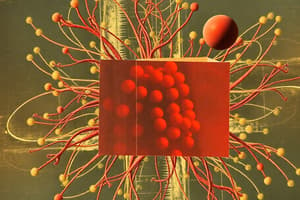Podcast
Questions and Answers
What are excitable tissues?
What are excitable tissues?
Muscle and nerve tissues that can respond to stimuli by producing action potentials.
What is irritability?
What is irritability?
The ability of all living tissues to respond to stimuli.
What is excitability?
What is excitability?
The ability of specialized cells to produce electrical signals known as action potentials.
What are the two basic properties of excitable cell membranes?
What are the two basic properties of excitable cell membranes?
What is the resting membrane potential?
What is the resting membrane potential?
What does the Nernst equation determine?
What does the Nernst equation determine?
What is the equilibrium potential for K+?
What is the equilibrium potential for K+?
What is the equilibrium potential for Na+?
What is the equilibrium potential for Na+?
Excitable cells are capable of transmitting electrical signals.
Excitable cells are capable of transmitting electrical signals.
Flashcards are hidden until you start studying
Study Notes
Introduction to Excitable Tissues
- Excitable tissues have the unique ability to respond to stimuli, generating electrical signals known as action potentials.
- Key examples include muscle and nerve tissues, which are capable of transmitting electrochemical impulses due to their polarized membranes.
Definitions and Importance
- Irritability: The capacity of living tissues to respond to both external and internal stimuli.
- Excitability: Specialized cells' ability to produce action potentials in response to stimuli.
- These properties are essential for functions such as muscle contraction and nerve signal transmission.
Characteristics of Excitable Cell Membranes
- Membranes exhibit electrical excitability, allowing transmission of impulses.
- Contain various ion channels that can open or close to regulate ion flow (e.g., Na⁺, K⁺).
Resting Membrane Potential
- The resting membrane potential is the voltage across a membrane when the cell is not actively sending signals.
- It is recorded as less negative (or more positive) inside the cell compared to the outside owing to ion distribution.
Electrical Phenomena in Nerve Cells
- Changes in membrane potential can be observed through a cathode ray oscilloscope, revealing upward (less negative) or downward (more negative) deflections.
- When electrodes are outside the membrane, the recorded potential is zero, transitioning to a negative value as they enter the cell.
Nernst Equation and Equilibrium Potential
- The Nernst equation calculates the equilibrium potential, which prevents the net diffusion of specific ions across the membrane.
- Key equilibrium potentials:
- K⁺: approximately -90 mV
- Na⁺: approximately +60 mV
- Despite these potentials, the major ions (Na⁺, K⁺, Cl⁻, Ca²⁺) are not in electrochemical equilibrium; rather, they maintain stable concentrations relative to the extracellular environment, a state termed nonequilibrium steady state.
Clinical Example
- A case study of a 9-year-old boy who experiences weakness and muscle spasms after physical activity raises questions regarding ionic imbalances, particularly potassium, which is critical to muscle function.
Conclusion
- Understanding excitable tissues is foundational for grasping the mechanisms underlying muscle contraction, nerve signal transmission, and the role of ions in maintaining membrane potentials.
Studying That Suits You
Use AI to generate personalized quizzes and flashcards to suit your learning preferences.




